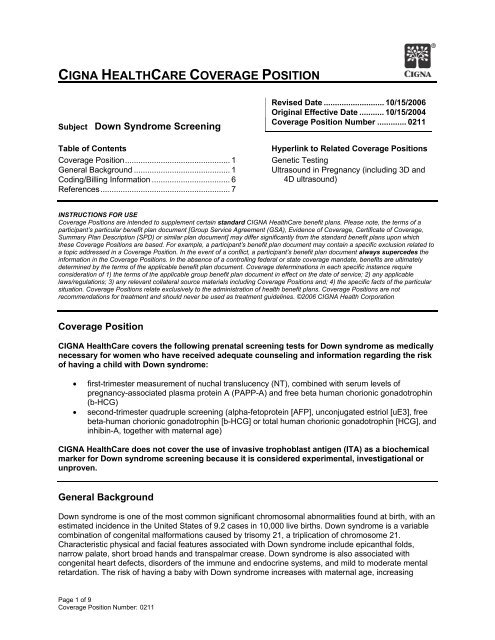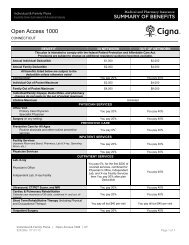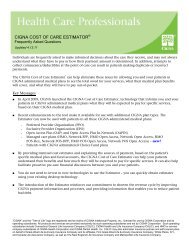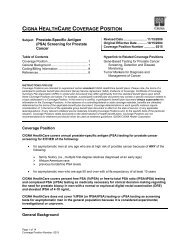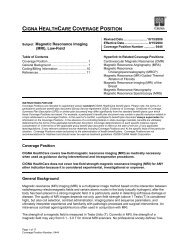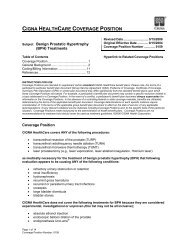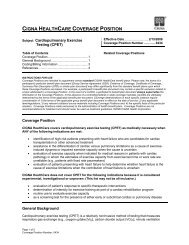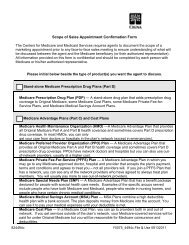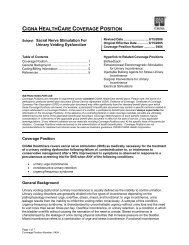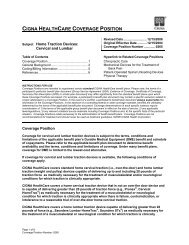Down Syndrome Screening â (0211)
Down Syndrome Screening â (0211)
Down Syndrome Screening â (0211)
Create successful ePaper yourself
Turn your PDF publications into a flip-book with our unique Google optimized e-Paper software.
ecommend a specific multiple-marker screening protocol. Counseling regarding screening should includeinformation on the procedure itself, the likelihood of follow-up testing with amniocentesis and itsassociated risks, as well as a full discussion of the potential outcomes associated with delivering a childwith <strong>Down</strong> syndrome and of aborting a <strong>Down</strong> syndrome fetus” (USPSTF, 1996). The USPSTF is currentlyupdating these recommendations to incorporate new evidence. According to USPSTF, the 1996recommendation may contain information that is out of date.In June 2004, the American College of Obstetricians and Gynecologists (ACOG) issued a position onfirst-trimester screening methods. According to the committee opinion, first-trimester screening for geneticdefects is now an option for pregnant women. New technologies, such as measuring NT, have allowed forearlier, noninvasive screening for chromosomal abnormalities and, when combined with serum screeningin the first trimester, have detection rates comparable to standard, second-trimester screening. Thecommittee opinion goes on to emphasize that sonographer training and ongoing quality assurance areessential if NT is used as a screening method. Since small differences in NT measurement cansignificantly affect the risk prediction of <strong>Down</strong> syndrome, sonographers will need to be monitored closely.ACOG does not recommend the use of NT measurement by itself to screen for <strong>Down</strong> syndrome, as thetest has a high positive screen rate when used without serum markers. First-trimester screening shouldbe used only if ALL of the following criteria are met:• Appropriate ultrasound training and ongoing quality monitoring programs are in place.• Sufficient information and resources are available to provide comprehensive counseling towomen regarding the different screening options and limitations of these tests.• Access to an appropriate diagnostic test is available when screening tests are positive.Although NT ultrasonography has pushed screening for <strong>Down</strong> syndrome into the first trimester, severalpractical issues need to be addressed before this type of screening finds its place in routine clinicalpractice. NT ultrasound is operator-dependent and is a challenging technique for general obstetricscreening, unless strict guidelines and ongoing quality control measures are in place. Appropriatetraining, adherence to a standard and reproducible technique, and experience are integral to the successof NT ultrasound as a reliable screening tool (ACOG, 2004).The Nuchal Translucency Quality Review (NTQR) credentialing program supported by the SMFM, ACOGand the American Institute of Ultrasound in Medicine (AIUM) was initiated in February 2005. The NTQRprogram goals include the following (NTQR, 2005):• educating providers on how to obtain reproducible NT measurements• providing a method to evaluate and track provider proficiency• providing ongoing NT quality reviewSummaryThe technology of first-trimester screening continues to evolve. It has been demonstrated that thecombination of nuchal translucency (NT) measurement and serum testing (i.e., pregnancy-associatedplasma protein A [PAPP-A] and free beta human chorionic gonadotrophin [b-HCG]) in the first trimester isan effective screening tool for <strong>Down</strong> syndrome. First-trimester screening does not eliminate the need forsecond-trimester ultrasound for detecting gross structural fetal anomalies. Currently, many health careproviders recommend that one ultrasound examination be included, usually between 18 and 20 weeks ofpregnancy, as a routine part of prenatal care. The use of ultrasonography in the second trimester toassess potential fetal abnormalities, confirm the site of pregnancy within the uterus, and determinegestational age is considered standard of care. Maternal serum AFP, if analyzed in the first trimester, alsodoes not provide the needed information regarding neural tube defects. Eliminating second-trimesterscreening altogether would lead to missing more cases of neural tube defects. In addition, approximately25% of pregnant women in the United States do not seek prenatal care early enough to be candidates forfirst-trimester screening. Second-trimester serum testing will likely remain an important part of antenatalscreening (Brigatti, Malone, 2004).Although promising, at this time there is insufficient evidence in the published peer-reviewed medicalliterature to support the use of invasive trophoblast antigen (ITA) as a substitute for free b-HCG in anyPage 5 of 9Coverage Position Number: <strong>0211</strong>
screening panel. Larger, well-designed studies are needed to further define the role of this biochemicalmarker.Coding/Billing InformationNote: This list of codes may not be all-inclusive.Covered when medically necessary:CPT ® * DescriptionCodes76801 Ultrasound, pregnant uterus, real time with image documentation, fetal andmaternal evaluation, after first trimester (< or = 14 weeks 0 days),transabdominal approach; single or first gestation76805 Ultrasound, pregnant uterus, real time with image documentation, fetal andmaternal evaluation, after first trimester (>or = 14 weeks 0 days), transabdominalapproach; single or first gestation76811 Ultrasound, pregnant uterus, real time with image documentation, fetal andmaternal evaluation plus detailed fetal anatomic examination, transabdominalapproach; single or first gestation80415 Chorionic gonadotrophin stimulation panel: estradiol response82105 Alpha-fetoprotein, serum82670 Estradiol82677 Estriol84163 Pregnancy-associated plasma protein-A (PAPP-A)84702 Gonadotrophin, chorionic (hCG), quantitative84703 Gonadotrophin, chorionic (hCG), qualitative86336 Inhibin AHCPCSCodesS3625S3626DescriptionMaternal serum triple marker screen including alpha-fetoprotein (AFP), estriol,and human chorionic gonadotropin (HCG)Maternal serum quadruple marker screen including alpha-fetoprotein (AFP),estriol, human chorionic gonadotropin (HCG), and inhibin aICD-9-CM DescriptionDiagnosisCodes758.0 <strong>Down</strong> syndrome758.1 Patau’s syndrome (trisomy 13)758.2 Edward’s syndrome (trisomy 18)758.31 – Autosomal deletion syndromes758.39758.5 Other conditions due to autosomal anomalies758.81 Other conditions due to sex chromosome anomalies758.89 Other conditions due to chromosome anomalies758.9 Conditions due to anomaly of unspecified chromosomeV28.3 <strong>Screening</strong> for malformation using ultrasonicsV28.8 Other specified antenatal screeningV28.9 Unspecified antenatal screeningExperimental/Investigational/Unproven/Not Covered:CPT* CodesDescriptionPage 6 of 9Coverage Position Number: <strong>0211</strong>
No specific codes*Current Procedural Terminology (CPT ® ) © 2005 American Medical Association: Chicago, IL.References1. American College of Obstetricians and Gynecologists (ACOG). ACOG issues position on firsttrimesterscreening methods. Accessed Aug 25, 2004. Available at URL address:http://www.acog.org2. Argawal R. Prenatal diagnosis of chromosomal anomalies: pictorial essay. Ind J Radiol Imag.2003;13:2:173-187.3. Bernstein PS. Highlights from the Society of Maternal-Fetal Medicine 24th Annual ClinicalMeeting. Medscape Ob/Gyn & Women’s Health 9(1). 2004 Mar.4. Brigatti KW, Malone FD. First-trimester screening for aneuploidy. Obstet Gynecol Clin North Am.2004 Mar;31(1):v,1-20.5. Canick JA, Saller DN Jr, Lambert-Messerlian GM. Prenatal screening for <strong>Down</strong> syndrome:current and future methods. Clin Lab Med. 2003 Jun;23(2):395-411.6. Center for Disease Control. National Center on Birth Defects and Developmental Disabilities.Accessed Aug 27, 2004. Available at URL address:http://www.cdc.gov/ncbddd/bd/keyfind.htm#top7. Cole LA, Shahabi S, Oz UA, Bahado-Singh RO, Mahoney J. Hyperglycosylated human chorionicgonadotropin (invasive trophoblast antigen) immunoassay: A new basis for gestational <strong>Down</strong>syndrome screening. Clin Chem. 1999 Dec;45(12):2109-19.8. D'Alton M, Cleary-Goldman J. First and second trimester evaluation of risk for fetal aneuploidy:the secondary outcomes of the FASTER Trial. Semin Perinatol. 2005 Aug;29(4):240-6.9. Driscoll DA; Professional Practice and Guidelines Committee. Second trimester maternal serumscreening for fetal open neural tube defects and aneuploidy. Genet Med. 2004 Nov-Dec;6(6):540-1.10. Fuchs KM, Peipert JF. First Trimester <strong>Down</strong> <strong>Syndrome</strong> <strong>Screening</strong>: Public Health Implications.Semin Perinatol. 2005 Aug;29(4):267-271.11. Hayes Medical Technology Directory. First-Trimester Prenatal <strong>Screening</strong> Using NuchalTranslucency Combined With Maternal PAPP-A and Free B-hCG Levels. Lansdale, PA: HAYESInc.; © 2005 Winifred S. Hayes, Inc. Originally published 2001 July. Update 2005 Dec.12. Institute for Clinical Systems Improvement. Technology Assessment Report April, 2002. FirstTrimester Prenatal Testing for <strong>Down</strong> <strong>Syndrome</strong> using Nuchal Translucency. Accessed Aug 31,2004. Available at URL address: http://www.icsi.org/knowledge/detail.asp13. Lazarus E. What's new in first trimester ultrasound. Radiol Clin North Am. 2003 Jul;41(4):663-79.14. Malone FD, Berkowitz RL, Canick JA, D'Alton ME. First-trimester screening for aneuploidy:research or standard of care? Am J Obstet Gynecol. 2000 Mar;182(3):490-6.15. Malone FD, Wald NJ, Canick JA, Ball RH, Nyberg DA, Comstock CH, et al. First- and secondtrimesterevaluation of risk (FASTER) trial: Principal results of the NICHD multicenter <strong>Down</strong>syndrome screening study, abstract. Am J Obstet Gynecol. 2003 Dec; Supplement;189(6).Page 7 of 9Coverage Position Number: <strong>0211</strong>
16. Malone FD, Canick JA, Ball RH, Nyberg DA, Comstock CH, Bukowski R, et al. First-trimester orsecond-trimester screening, or both, for <strong>Down</strong>'s syndrome. N Engl J Med. 2005 Nov10;353(19):2001-11.17. Malone FD, D'Alton ME; Society for Maternal-Fetal Medicine. First-trimester sonographicscreening for <strong>Down</strong> syndrome. Obstet Gynecol. 2003 Nov;102(5 Pt 1):1066-79.18. March of Dimes. Maternal blood screening for <strong>Down</strong> syndrome and neural tube defects.Accessed Aug 31, 2004. Available at URL address:http://www.marchofdimes.com/professionals/professionals.asp19. National Institute of Child Health and Human Development (NICHD). Facts about <strong>Down</strong>syndrome. Accessed Aug 25, 2004. Available at URL address:http://www.nichd.nih.gov/publications/pubs/downsyndrome/down.htm20. Nicolaides KH. Nuchal translucency and other first-trimester sonographic markers ofchromosomal abnormalities. Am J Obstet Gynecol. 2004 Jul;191(1):45-67.21. Nicolaides KH, Spencer K, Avgidou K, Faiola S, Falcon O. Multicenter study of first-trimesterscreening for trisomy 21 in 75 821 pregnancies: results and estimation of the potential impact ofindividual risk-orientated two-stage first-trimester screening. Ultrasound Obstet Gynecol. 2005Mar;25(3):221-6.22. No authors listed. ACOG Committee Opinion #296: first-trimester screening for fetal aneuploidy.Obstet Gynecol. 2004 Jul;104(1):215-7.23. NTD Laboratories Inc. Ultra-Screen ® Instant Risk Assessment. © Copyright 2005NTD Laboratories, Inc. Accessed September 8, 2005. Available at URL address:http://www.ntdlabs.com/ira.php24. Nuchal Translucency Education and Quality Review Program. February 2005. AccessedSeptember 8, 2006. Available at URL address:https://www.ntqr.org/SM/Documentation/NTbooklet7.10.06.pdf25. Palomaki GE, Knight GJ, Neveux LM, Pandian R, Haddow JE. Maternal serum invasivetrophoblast antigen and first-trimester down syndrome screening. Clin Chem. 2005Aug;51(8):1499-504. Epub 2005 Jun 16.26. Pandian R, Cole LA, Palomaki GE. Second-trimester maternal serum invasive trophoblastantigen: a marker for <strong>Down</strong> syndrome screening. Clin Chem. 2004 Aug;50(8):1433-5. Epub 2004May 27.27. Reddy UM, Mennuti MT. Incorporating first-trimester <strong>Down</strong> syndrome studies into prenatalscreening: executive summary of the National Institute of Child Health and Human Developmentworkshop. Obstet Gynecol. 2006 Jan;107(1):167-73.28. Rosen T, D'Alton ME. <strong>Down</strong> syndrome screening in the first and second trimesters: what do thedata show? Semin Perinatol. 2005 Dec;29(6):367-75.29. U.S. Preventive Services Task Force (USPSTF). <strong>Screening</strong> for <strong>Down</strong> <strong>Syndrome</strong>. Guide toClinical Preventive Services. 2 nd Edition 1996. Accessed September 11, 2006. Available at URLaddress: http://www.ncbi.nlm.nih.gov/books/bv.fcgi?rid=hstat3.section.10931#1430330. Wald NJ. First-trimester screening for <strong>Down</strong>'s syndrome. N Engl J Med. 2004 Feb 5;350(6):619-21.Page 8 of 9Coverage Position Number: <strong>0211</strong>
31. Wald NJ, Rodeck C, Hackshaw AK, Rudnicka A. SURUSS in perspective. BJOG. 2004Jun;111(6):521-31.32. Wald NJ, Rodeck C, Hackshaw AK, Walters J, Chitty L, Mackinson AM. First and secondtrimester antenatal screening for <strong>Down</strong>'s syndrome: the results of the Serum, Urine andUltrasound <strong>Screening</strong> Study (SURUSS). J Med Screen. 2003;10(2):56-104.33. Wapner R, Thorn E, Simpson JL, Pergament E, Silver,R, Filkins K, et al. First-trimester screeningfor trisomies 21 and 18. N Engl J Med. 2003 Oct;349(15):1405-12.34. Wapner RJ. First trimester screening: the BUN study. Semin Perinatol. 2005 Aug;29(4):236-9.35. Weinans MJ, Sancken U, Pandian R, van de Ouweland JM, de Bruijn HW, Holm JP, et al.Invasive trophoblast antigen (hyperglycosylated human chorionic gonadotropin) as a firsttrimesterserum marker for <strong>Down</strong> syndrome. Clin Chem. 2005 Jul;51(7):1276-9.36. Wenstrom KD. Evaluation of down syndrome screening strategies. Semin Perinatol. 2005Aug;29(4):219-24.Page 9 of 9Coverage Position Number: <strong>0211</strong>


